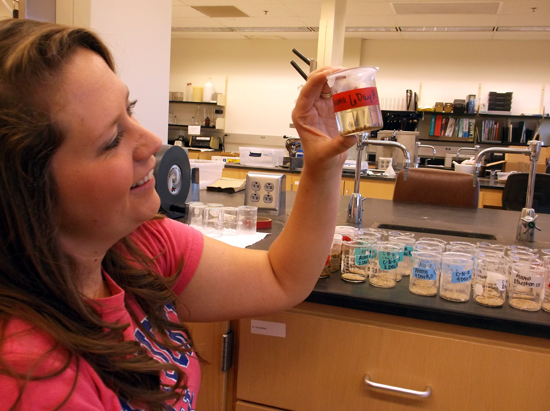Research finding improves switchgrass establishment
Research finding improves switchgrass establishment

Switchgrass is a multipurpose crop native to Kentucky. Once established, switchgrass grows well on marginal land, but it takes several years to produce a significant crop. Researchers in the University of Kentucky College of Agriculture, Food and Environment have investigated methods to improve establishment time, which could make the crop more appealing to some growers.
It typically takes producers at least two to three years to establish a harvestable crop, and for some it can take upwards of four years to get a significant yield. Factors leading to slow establishment include poor seed quality, slow germination and weed competition.
Researchers have conducted many studies on improving establishment, but many of the solutions, such as cold stratification, require specialized training.
Since the summer of 2012, UK graduate student Whitney Churchman and her adviser turfgrass scientist David Williams have been trying to find a relatively easy and inexpensive way to improve establishment. It appears a common turfgrass management strategy to improve and hasten germination could work.
“A strategy used quite frequently to hasten germination in turfgrass management is to simply soak the seeds in water prior to planting,” Churchman said.
For the project, Churchman used Alamo and Cave-in-Rock switchgrass varieties. Groups of seeds were soaked in water for either, two, four or six days or not at all. She also compared this with soaking the seeds for one day in two different strengths of ethephon, a widely used plant growth regulator.
“Our seed pre-treatments significantly affected plant density, which means more plants per square foot,” Churchman said. “The seeds that were soaked in water for six days in the case of Alamo and Cave-in-Rock both yielded more dense plants and increased the number of tillers over time, which means they had a more successful germination and establishment rate.”
During 2012 field trial, the earliest germination occurred three days after seeding, and the entire trial germinated four days after seeding. In 2013, the earliest germination occurred two days after seeding with the complete trial germinated within seven days. Alamo germinated quicker and produced more dense plants than Cave-in-Rock in all trials. Cave-in-Rock soaked for six days in water germinated one day faster than all other Cave-in-Rock trials in 2012. It also germinated two days quicker than the control plots, and the plots with the variety soaked in water for two days in 2013. In addition this year, Cave-in Rock soaked in water for four days and both strengths of ethephon germinated at the same time as Cave-in-Rock soaked in water for six days.
The results are encouraging because this pre-treatment is something a farmer can do alone without much of a capital investment. Seed, water and a 55 gallon drum are the only materials needed, Williams said.
Not only could these seed pre-treatments help with establishment, but it could provide some natural weed control.
“A big issue with switchgrass establishment is getting the grass growing before the weeds become so competitive that establishment is unsuccessful,” Williams said. “When you have denser, desirable plants, you’re going to have fewer weeds.”
Churchman is taking results of her field study to the lab to further investigate the effects of seed pre-treatment on germination velocity. She is also conducting a greenhouse study testing the effects of two herbicides on switchgrass.
She will present the results of her studies at the annual meetings of the American Society of Agronomy and the North Central Weed Science Society.
Crops Extension Research


